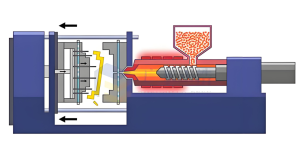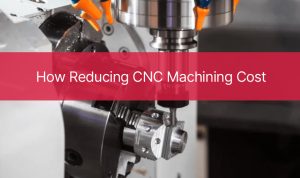Multi-component injection molding provides new possibilities for plastic processing, combining different materials or colors in a single molding. Production can be done in one process without other assembly or out-of-machine post-processing steps. Multi-component injection molding is a fully automatic process with a high flexibility, especially suitable for mass production.
The finished parts can have a variety of functions and characteristics. Using this process, colored parts with high pressure, heat, or chemical resistance can be produced.
The concept of multi-component injection molding covers multiple independent processes. These processes have in common the simultaneous injection of a corresponding number of different materials into the mold by two or more injection molding devices in a series of steps to produce the final product. The final part can be used without further processing.
The number of gates, it can be divided into two groups:
Use of single gate systems, including sandwich and alternate injection molding processes.
Multi-gate systems can be preliminarily classified according to core-pulling and transfer processes. The transfer process involves the transfer between two standard machines by the manipulator system and, in specific multi-component machines, by the rotation of the manipulator system and the die. Mold rotation includes:
- The rotation of movable half die.
- The rotation of mold internals.
- The rotation of a vertical axis through a the rotating device (GRAMTM process).
Application Advantages:

Advantages of multi-component injection molding: In multi-component injection molding, the components of the molded part are completely separated from each other. All components are visible to the surface, reflecting the appearance and function of the part.
For example, keyboard buttons, logo switches, or handles with soft areas for added comfort. In addition to the advantage of producing injection-molded parts of multiple colors or materials in one process without additional assembly or subsequent processing, continuous improvements in molding technology can bring growing benefits.
The tolerance of injection molded parts to external effects (mechanical, thermal, or chemical effects) is achieved through the proper combination of materials and high bonding strength. The degree of adhesion of two-component bonded surfaces can be achieved by chemical bonding or mechanical bonding. If chemically compatible materials are used, melting or welding processes can also achieve permanent molecular bonding.
Two-component Injection Molding:
The fully automatic two-component injection molding mold has two stations. The molded parts are pre-injected through another injection stage to complete the production of the parts. The prefabricated parts are produced in the first cavity. The mold is then opened and the whole movable half is rotated 180°to rotate the prefabricated cavity to the final injection position. The prefabricated part is then manufactured into the final part by adding a second material. The mold cavity can rotate in the same direction or alternately. After the final part is demoulded, the cavity can be prefabricated again.
To make part demoulding independent of the production process, a demoulding station is integrated into the two-component molding. The mold is then rotated clockwise. On the side of the third station, there is an opening from which the manipulator system gripper can reach into a closed mold to release the parts and their gates and place them on the conveyor belt for further processing.
Try Made by Aria Now
All information and uploads are secure and confidential.
Three or More Components For Injection Molding:

Various methods can achieve the molding process of more than three components. Here are two possible approaches.
Two-station mould:
The setup of a two-station mold can be done like the previous setup of a three-component mold. Three or more (up to five) components are simultaneously injected to produce a prefabricated part in the first process step. Then, the full half of the mold is rotated 180 to move to the second position. At this point, other materials are injected to seal the prefab and produce the final part.
Another method is in a corresponding configuration mold, where parts can be combined with five surface elements made of other materials/colors in a single production step. Thus, inserts in the mold can be rotated between three stations by rotating templates and electrically driven rotators.
Four-station mold:
For example, multilayer plastic parts can be produced using four-station molds. This method is easy to implement when using recycled materials and barrier layers. The innermost layer is produced at the first stop. Then, the mold is rotated 90°; To the next stop. At this point, a second component is used to encapsulate the first component by injection molding. The half-die then continues to rotate to a third stop and finally to a fourth stop for the final production stage.
At this point, the protective outer layer, or surface of the molded part, is injected into the part. After a cooling phase, the final multilayer part is released from the cavity. Each time the mold is opened in a continuous cycle, a final forming part is produced.
Alternate injection molding, in which two different colors of the same plastic component are injected alternately into the same cavity.
Before entering the mold, both colors are placed in a special mixing nozzle. The two-color components are mixed to form a color effect. The two colors can be purposely mixed in configuration. In alternating injection molding, the two injection molding devices are joined together by a special alternating injection molding device with a mixing nozzle.
Sandwich Injection Molding:
The sandwich injection molding process injects a core material into the outer layer. The process takes place in two or three steps in a cavity.
First, the surface material is injected into the cavity portion. The core components are then injected through the first material into the inner center. Finally, seal the gate position with the first component. This prevents the appearance of core material on the surface and removes the second component from the gate system for the next injection of the first component.
Try Made by Aria Now
All information and uploads are secure and confidential.
Assembly Injection Molding:
With a rotary die, components that need to be assembled after injection molding can be formed separately on a two-component machine and then assembled in a die. An example of a seal assembled in a cable conduit illustrates how the assembly process can be implemented in a mold. The two individual components are first molded simultaneously at their respective die stations.
Then, after opening the mold, the first element is transferred to the second station by rotating the insert and placed on top of the second element core. The assembly of the two parts is accomplished utilizing a spindle die. As a result, subsequent steps and complex automation solutions can be eliminated.
Conclusion
Multi-component injection molding will become more and more important in the future. In particular, the technology for making hard and soft combinations is only just beginning to develop. The use of assembly injection molding can achieve the reasonable integration of various functional elements shortly and gradually replace the coupling process.
Try Made by Aria Now
All information and uploads are secure and confidential.
Categories
Share On
Recent Post

Commonly Plastic Injection Molding Process Parameters
Drilling countersinks is more than just drilling a simple hole

Design Tips For Reducing CNC Machining Costs
Despite the presence of newer and more advanced technologies, like


